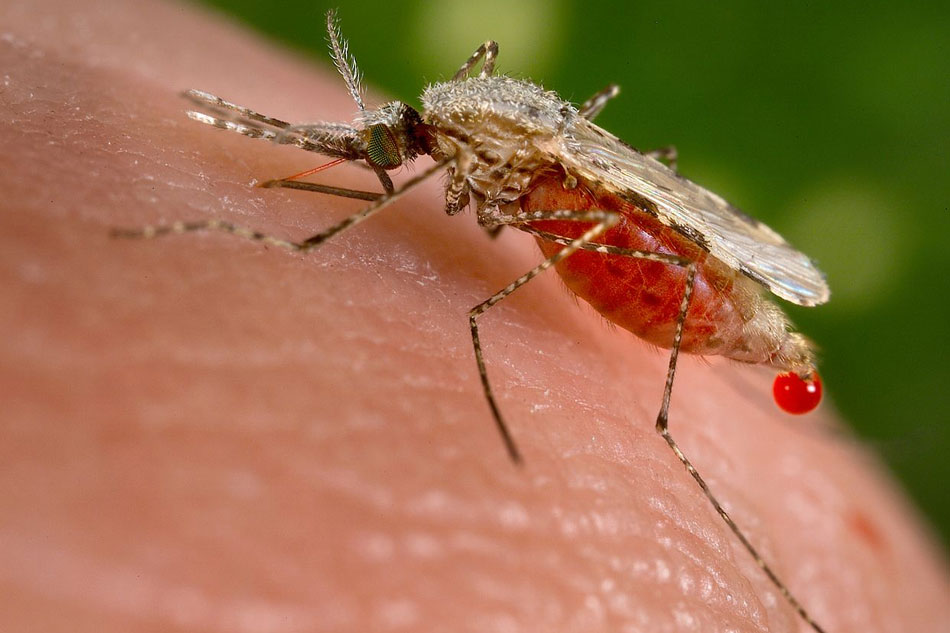Philippines on track to eradicate malaria by 2030 — WHO | ABS-CBN

Welcome, Kapamilya! We use cookies to improve your browsing experience. Continuing to use this site means you agree to our use of cookies. Tell me more!
Philippines on track to eradicate malaria by 2030 — WHO
Philippines on track to eradicate malaria by 2030 — WHO
Davinci Maru,
ABS-CBN News
Published Feb 13, 2020 05:02 PM PHT
|
Updated Feb 13, 2020 07:29 PM PHT
MANILA - The Philippines is on track in its efforts to wipe out malaria by 2030, a World Health Organization (WHO) official said Thursday, as cases of the mosquito-borne disease have dropped 10-fold in nearly 2 decades.
MANILA - The Philippines is on track in its efforts to wipe out malaria by 2030, a World Health Organization (WHO) official said Thursday, as cases of the mosquito-borne disease have dropped 10-fold in nearly 2 decades.
Malaria infections fell from nearly 50,000 in 2003 to more than 5,000 in 2019, data from the National Malaria Control and Elimination Program of the Department of Health (DOH) show.
Malaria infections fell from nearly 50,000 in 2003 to more than 5,000 in 2019, data from the National Malaria Control and Elimination Program of the Department of Health (DOH) show.
"The Philippines is on the correct track. When you compare it to other countries in the Asia-Pacific region, after China, the Philippines is the second country aiming for elimination," said Dr. Gawrie Galappaththy, WHO Philippines' medical officer on malaria and other vector-borne and parasitic diseases.
"The Philippines is on the correct track. When you compare it to other countries in the Asia-Pacific region, after China, the Philippines is the second country aiming for elimination," said Dr. Gawrie Galappaththy, WHO Philippines' medical officer on malaria and other vector-borne and parasitic diseases.
"Although the government target is 2030, I think with the help of [Pilipinas] Shell [Foundation Inc.], DOH and all the people, we can do it before that," she added.
"Although the government target is 2030, I think with the help of [Pilipinas] Shell [Foundation Inc.], DOH and all the people, we can do it before that," she added.
ADVERTISEMENT
In 2019, the Philippines recorded 5,730 cases of malaria, which is caused mainly by plasmodium parasites carried by mosquitoes and spread through bites.
In 2019, the Philippines recorded 5,730 cases of malaria, which is caused mainly by plasmodium parasites carried by mosquitoes and spread through bites.
Of the total, 5,612 cases were in hard-to-reach areas in Palawan, which is susceptible to the disease because of its dense forest -- a suitable breeding habitat for malaria-carrying mosquitoes.
Of the total, 5,612 cases were in hard-to-reach areas in Palawan, which is susceptible to the disease because of its dense forest -- a suitable breeding habitat for malaria-carrying mosquitoes.
Most of the victims were members of Philippine ethnic groups who wear loincloth, said Marvi Trudeau, deputy executive director of PSFI, which supports the government's efforts in stamping out the disease through its Movement Against Malaria (MAM) program.
Most of the victims were members of Philippine ethnic groups who wear loincloth, said Marvi Trudeau, deputy executive director of PSFI, which supports the government's efforts in stamping out the disease through its Movement Against Malaria (MAM) program.
"With the dense forest [and] since the indigenous people hindi nakabihis, parang ang sarap talagang kagatin ng lamok. The right combination makes it so good for malaria," she told reporters during a press conference in Bonifacio Global City.
"With the dense forest [and] since the indigenous people hindi nakabihis, parang ang sarap talagang kagatin ng lamok. The right combination makes it so good for malaria," she told reporters during a press conference in Bonifacio Global City.
Despite an increase of malaria infection in 2019 compared to 2018 with 4,899, the Philippine government has made great strides against the disease and is inching towards its elimination, Trudeau said.
Despite an increase of malaria infection in 2019 compared to 2018 with 4,899, the Philippine government has made great strides against the disease and is inching towards its elimination, Trudeau said.
ADVERTISEMENT
Out of 81 provinces, 60 had been declared malaria-free, 18 were in the elimination phase while the disease remained endemic in 3 provinces, DOH data reveal.
Out of 81 provinces, 60 had been declared malaria-free, 18 were in the elimination phase while the disease remained endemic in 3 provinces, DOH data reveal.
Apart from Palawan, local transmissions of malaria were reported in Sultan Kudarat and Occidental Mindoro.
Apart from Palawan, local transmissions of malaria were reported in Sultan Kudarat and Occidental Mindoro.
"We've seen an increase of confirmed cases because we are actively finding people possibly carrying the parasite," added Trudeau, whose Shell-supported MAM program has helped educate people and treat the disease since 1999. It received a $31.4-million grant from the Global Fund to Fight Aids, Tuberculosis and Malaria in 2009.
"We've seen an increase of confirmed cases because we are actively finding people possibly carrying the parasite," added Trudeau, whose Shell-supported MAM program has helped educate people and treat the disease since 1999. It received a $31.4-million grant from the Global Fund to Fight Aids, Tuberculosis and Malaria in 2009.
Though malaria is not as widespread as other mosquito-borne diseases such as dengue, it has claimed at least 877 lives in the Philippines since 2003.
Though malaria is not as widespread as other mosquito-borne diseases such as dengue, it has claimed at least 877 lives in the Philippines since 2003.
Eight deaths were recorded in 2019, wherein 6 of the victims contracted the disease abroad.
Eight deaths were recorded in 2019, wherein 6 of the victims contracted the disease abroad.
ADVERTISEMENT
People infected with malaria experience fever, headache and chills, among others. If left untreated, it may develop into severe illness and possibly death.
People infected with malaria experience fever, headache and chills, among others. If left untreated, it may develop into severe illness and possibly death.
WHAT'S NEXT?
As authorities set their sights on 2030 for a malaria-free Philippines, they've committed to double down measures to meet the target.
As authorities set their sights on 2030 for a malaria-free Philippines, they've committed to double down measures to meet the target.
"We have to be very aggressive in finding these people [with malaria] and treat them," said Galappaththy, who has done research about the disease for 25 years.
"We have to be very aggressive in finding these people [with malaria] and treat them," said Galappaththy, who has done research about the disease for 25 years.
The Philippines, she said, must continue using existing malaria-fighting tools, such as medicated mosquito nets and medicines to combat the disease.
The Philippines, she said, must continue using existing malaria-fighting tools, such as medicated mosquito nets and medicines to combat the disease.
As of now, there's no effective malaria vaccine. The world's first malaria vaccine, backed by Microsoft co-founder Bill Gates, is exclusive for use in African countries.
As of now, there's no effective malaria vaccine. The world's first malaria vaccine, backed by Microsoft co-founder Bill Gates, is exclusive for use in African countries.
ADVERTISEMENT
"This vaccine works only for 1 human parasite. This vaccine is exclusive for African countries. This parasite is more prevalent in Africa and more children are dying from malaria... However, as of now, results show this does not give 100 percent protection, but it prevents the deaths. Can this vaccine be brought here? I will say, no. First of all, it's just 5,000 cases in Palawan. This is a remarkable success story in the Philippines... Clearly, I don't see a room of vaccine production in the country," Galappaththy said.
"This vaccine works only for 1 human parasite. This vaccine is exclusive for African countries. This parasite is more prevalent in Africa and more children are dying from malaria... However, as of now, results show this does not give 100 percent protection, but it prevents the deaths. Can this vaccine be brought here? I will say, no. First of all, it's just 5,000 cases in Palawan. This is a remarkable success story in the Philippines... Clearly, I don't see a room of vaccine production in the country," Galappaththy said.
For the PSFI, who has helped set up hundreds of microscopy laboratories in Palawan, they are planning to put up halfway houses, where locals who contract malaria can be diagnosed and treated.
For the PSFI, who has helped set up hundreds of microscopy laboratories in Palawan, they are planning to put up halfway houses, where locals who contract malaria can be diagnosed and treated.
"We will empower local government units to be more vigilant because there's a threat that it can recur and all the things we have done in the last 20 years will be a waste," Trudeau said.
"We will empower local government units to be more vigilant because there's a threat that it can recur and all the things we have done in the last 20 years will be a waste," Trudeau said.
To symbolize PSFI's fight against malaria, contemporary fine artist Leeroy New created an art installation called "Fortress."
To symbolize PSFI's fight against malaria, contemporary fine artist Leeroy New created an art installation called "Fortress."
The project, made of treated mosquito nets, nylon wire and steel, was meant to "protect the body and peace of mind from the threat of mosquito-borne infections."
The project, made of treated mosquito nets, nylon wire and steel, was meant to "protect the body and peace of mind from the threat of mosquito-borne infections."
Read More:
malaria
mosquito
World Health Organization
WHO
Pilipinas Shell Foundation Inc.
PSFI
Shell
Palawan
Department of Health
DOH
ADVERTISEMENT
ADVERTISEMENT



